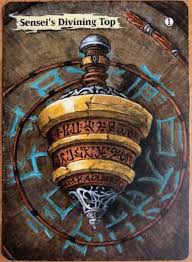Welcome to another weekly Deck Tech, where we dissect a deck that is putting up good results or that caught our attention in the last week.
Today, we return to Pauper, where the format has been polarized between Blue-Based decks, Affinity and Storm decks. And we'll dissect the deck that possibly less experienced players don't fully understand how it works and why it works: Storm.
Storm is a deck that promised to change the entire structure of the format since Chatterstorm was announced as part of Modern Horizons II, many content creators and people specialized in the format have criticized the fact that a new Storm card would enter the format when Empty the Warrens and Grapeshot are banned, and the format has not, in recent years, had any efficient means of responding to the deck as it was a relic of distant times.
Ad
Well, Modern Horizons II is out, and the Pauper Metagame has changed drastically and a lot of that is caused by the existence of Chatterstorm, as many decks simply don't have efficient ways to respond to the deck and can't establish the best race to deal with a deck that can win the game from turn 3.
Thus, some believe that even the predominance of Affinity today is a side effect of the inclusion of Chatterstorm, as this is one of the few decks that manages to establish a lot of pressure on the board and still have good reactive cards like Hydroblast and Dispel to respond to rituals, Manamorphose or First Day of Class.
That said, let's go to the list:
I am choosing to approach Rakdos Storm because it is the most explosive version and with the most expressive results. There is also the Izzet Storm version, which takes more turns to close the combo, but is less susceptible to cards like Cleansing Wildfire and has cards like Ponder and Preordain to add more consistency.
Rakdos Storm bets on lands that generate double mana, an abundance of rituals and cards that draw more than one card at a time to function, much like the templates introduced by the 2012 Storm when Frantic Search was banned.
Maindeck

Your goal is to make a huge number of spells and then cast Chatterstorm to lethal. It seems harmless to think that you need to play 19 spells to attack to lethal with the squirrels, but the deck has a very efficient way to significantly reduce that number:

The card that enabled Moggwarts is also the card that significantly reduces the number of spells needed before playing Chatterstorm, as it will make the Squirrel tokens to enter the battlefield with +1/+1 counter and Haste.
It's worth mentioning that the effect of First Day of Class is cumulative. Therefore, each First Day of Class played is a significant reduction in the number of spells needed to close the game in a single turn.
One First Day of Class reduces the number of spells to 8. Two First Day of Class reduces it to 5, and you usually already cast a lot more spells than that during the game.
As a bonus, the card can still serve to fetch a Lesson, which is relevant if you have cards like Pest Summoning, Introduction to Prophecy or Introduction to Annihilation, as you can also discard a useless card from your hand in exchange for drawing a card, helping the deck find the cards it needs.

In many ways, Storm works like a Glass Cannon, that is, a deck that accumulates an absurd number of resources at once, then throws its “bomb” to end the game in a single turn.
Therefore, it is possible to say that the great weakness of the deck is that, if you respond promptly to one card or another, the deck will take too long to recover and will not be able to close the combo in time again.
Galvanic Relay is exactly the “recharge” the deck needs, as it essentially tells this archetype to “Draw a card on your next turn” with Storm, often exiling all the cards you need to recover from the top to cast in the next turn and, if necessary, do so again in the other turn if you have another Galvanic Relay.
Ad
The card is essentially the engine that makes the deck never run out of gas and is used to its full potential when the deck's purpose is to win with another Storm spell or using a significant streak of spells in the same turn.

For the deck to play that many spells in one turn, it needs extra mana. And rituals are the perfect way to get that mana.
Lotus Petal is essentially a free spell that generates mana. It doesn't get any better than that, and it's one of the ways the deck has to generate green for Chatterstorm.
Rite of Flame is the best red ritual available, as it costs little and grows significantly for each copy already used throughout the game.
Dark Ritual is the oldest and most classic ritual Magic has: 1 mana to generate 3 is a considerable leap and very advantageous for Storm.
Cabal Ritual is often the ritual you want to avoid using first because it's only really worth it if you have the Threshold, where you'll pay 2 mana to generate 5, essentially adding more mana than any other ritual.

The deck can also make good use of manafixing effects, especially when Chatterstorm isn't usually in the colors the deck uses in its rituals.
Chromatic Star and Chromatic Sphere are mana stones that can be used to fix the mana, cost little to play to increase Storm's count, and are replaced by a card when sacrificed, allowing the deck to have more ways to find the cards you need to close the combo.
Manamorphose is an absurdly strong card in any archetype that cares about how many spells are used for the mere fact that it's a spell that's essentially played for free AND draws a card. The card has recently become a staple of Modern, and it wouldn't surprise me to see it have the same future on Pauper as long as Galvanic Relay exists.

Since this version doesn't have enough ways to add blue mana, the deck opts for draw spells to maximize the amount of cards in hand.
Night's Whisper and Sign in Blood are the best options the deck has available, as they can be used easily with rituals.

The deck only uses 13 lands, but that's enough considering that each of these lands adds double mana, and the deck has access to rituals and Lotus Petal.
Peat Bog and Sandstone Needle are temporary lands, but they allow the deck to ramp significantly the first few turns even when not going into the combo. Its use is limited to two activations, but it is usually more than enough to guarantee the spell chain.
Geothermal Crevice can serve either as a normal land drop that adds red or can be sacrificed to add two mana, including one green mana for Chatterstorm.
The Swamp on the list is an efficient way to deal with Cleansing Wildfire and Geomancer's Gambit, cards that have been used both to ramp with the new artifact lands and to respond to decks with a problematic manabase, such as the Storm's case, since its low number of lands makes it vulnerable.
Ad
Sideboard

Duress responds to 99% of what you need to deal with to get the combo off and can be played with a single black mana. It is a safe and efficient disruptive element that serves to respond to cards such as Echoing Truth, Echoing Decay, Fiery Cannonade, Hydroblast, Dispel, among others.

The card that really hampers Storm and doesn't get answered by Duress is Krark-Clan Shaman, which can deal enough damage to the entire board to deal with the tokens.
Gut Shot is a free and completely valid answer for dealing with this card, and it can also be useful for increasing the Storm count and/or dealing with Spellstutter Sprite and the like.

There are still decks that tries to hold the game back with prevention effects like Moment's Peace and Prismatic Strands.
Flaring Pain is the ideal answer for these decks. In fact, it is the only efficient answer the format has to deal with these effects.

It's strange that the deck has only one Pyroblast, but since the card essentially doesn't do anything you don't already do with other cards, it's acceptable to use it that way.
It's possible to say that Pyroblast is up to a fifth response against Blue-Based decks alongside Duress.

Sometimes all you need is to have some extra breath.
Decks like Burn and Affinity will have big complications if you manage to resolve a high number of Weather the Storm copies, as this will give you even more turns to create the perfect combo setup.
The card is also an acceptable and relevant option in Mirror.

Since First Day of Class has the Learn ability, having a Lesson can be helpful.
Introduction of Prophecy is essentially a Preordain that costs two more mana, but can be used with black or red mana. There are times when you really need to dig your deck to get to Chatterstorm and this card can be very useful for that.
The card can also be used for the next turn's Storm Setup, as it's another way to draw cards.
Peformance Analysis
I played few games with this list due to time constraints, but I can conclude that not only is the deck real, but it is absurdly consistent and manages to escape the interaction that many lists might have very well.
The reality is that opponents don't really have the means to deal with the deck, and often the best option they have is to try to advance their clock and go to the race, whereupon you can patiently wait a few turns to close the combo in the right sequence if the pressure is not fast enough.
Decks like Faeries, for example, need to practically hope to have the right answer when you cast Chatterstorm and that you don't go off too fast because otherwise you'll have a much more significant board presence, even if you don't deal lethal damage or even if they counter First Day of Class.
That's why we've seen decks like Dimir Delver and Dimir Faeries as the best viable blue deck options: Echoing Decay and Echoing Truth are two of the best responses the format has to the numerous Squirrel tokens. And the fact that these decks can use Gurmag Angler to establish significant pressure also goes a long way toward holding the archetype.
Ad
Affinity has a perfect mix of huge threats and relevant disruptive elements, especially Krark-Clan Shaman which essentially needs to be answered before you can perform the combo and ends up, on its own, creating several “extra turns” for the opponent.
Also, the archetype is one of the few that can simply save most of its mana to respond to what the player does, while applying enormous pressure with its creatures that come in for little or no mana.
Most other decks can simply make good decisions to deal with the archetype like populating the board like Elves does, or dealing direct damage like Burning, or trying to be disruptive enough like Mono-Black or Boros Bully using Cleansing Wildfire, but in the end, Storm seems to be above these decks because any small mistake by opponents poses a huge risk.
And here comes the concept of False Tempo that I talk about often: your opponents will be giving you extra turns every time they think you can combo off on the next turn. And they always think you will.
Therefore, they will never play their best cards the best way if they have an answer against you. And it's up to the player to capitalize on those turns and especially the extra mana their opponents give. The perfect example of how to do this is Galvanic Relay.

Galvanic Relay is essentially too powerful for the purpose this deck has, as it will always be “reloading” your hand for the next Storm sequence.
If you expect the opponent to have an answer to the combo, you can prioritize accumulating enough mana and resources to explode with the combo, and in case any steps go wrong, you can always use Galvanic Relay to make up for lost resources by gaining more resources to try to close the combo on the next turn.
One final note that is important to make is that it is not because you can Storm for lethal that you should Storm for lethal.
You can save-up resources, if necessary, to create another Storm chain on another turn as long as you create a board position so efficient (like 6 2/2 Squirrels) that your opponent will have a hard time getting back into the game in the first few turns, the which will give you even more time to create another Storm chain if they deal with the first.
Overall, Storm is a fun deck for those who like to do things that look broken and for those who like to do math. It's good to play and has a good placement in the format these days, but unfortunately, I don't see it lasting very long in the format as it's clear that this card is one of the main factors in the polarization of decks in the Metagame these days.
Conclusion
This is my analysis of Pauper's new Storm, which is one of the most impactful decks in the current Metagame and one of those responsible for the current state of the format.
As I mentioned in another previous article, I don't see Chatterstorm lasting longer than 45 days on Pauper, so I can't recommend anyone spending tix on cards like Lotus Petal and Night's Whisper which spiked up a lot in price. But, if you have your own loan program and the deck is in its budget, I recommend that you play at least one league with the deck to understand how powerful a single Storm card is when the whole environment makes this type of strategy extremely viable.
Ad
Personally, I wouldn't want to see Galvanic Relay have the same fate, as I can imagine interesting interactions with the card in this deck category with other threats and winconditions like Kiln Fiend, but the card makes "glass cannon strategies” much less risky and very rewarding, so I wouldn't be surprised if the card end up being banned as well.
Anyway, I can state with some certainty that a banned and restricted update for Pauper is a matter of “when” and not “if”.
Thanks for reading!







— Comments0
Be the first to comment